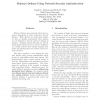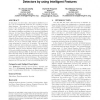109 search results - page 14 / 22 » Using IRP for Malware Detection |
111
Voted
SOCIALCOM
2010
14 years 6 months ago
2010
Protecting the integrity of software platforms, especially in unmanaged consumer computing systems is a difficult problem. Attackers may attempt to execute buffer overflow attacks ...
97
Voted
IWIA
2005
IEEE
15 years 5 months ago
2005
IEEE
Malware defenses have primarily relied upon intrusion fingerprints to detect suspicious network behavior. While effective for discovering computers that are already compromised,...
102
Voted
GECCO
2008
Springer
15 years 21 days ago
2008
Springer
In this paper, we show that a Bio-inspired classifier’s accuracy can be dramatically improved if it operates on intelligent features. We propose a novel set of intelligent feat...
106
Voted
WISTP
2010
Springer
15 years 6 months ago
2010
Springer
Widespread use and general purpose computing capabilities of next generation smartphones make them the next big targets of malicious software (malware) and security attacks. Given ...
71
Voted
VIROLOGY
2010
14 years 10 months ago
2010
This research proposes a novel automatic method (termed Auto-Sign) for extracting unique signatures of malware executables to be used by high-speed malware filtering devices based...


